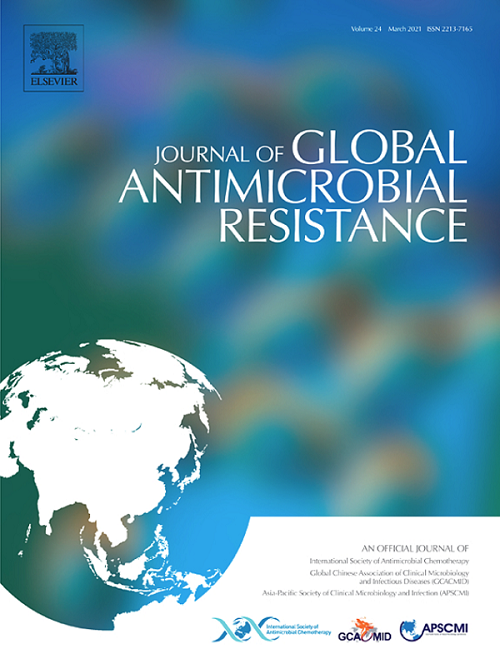中国农村金黄色葡萄球菌鼻腔携带:分子流行病学和抗菌药物敏感性。
IF 3.2
3区 医学
Q2 INFECTIOUS DISEASES
引用次数: 0
摘要
目的:研究中国农村健康人群中金黄色葡萄球菌的鼻腔携带流行情况、分子特征、耐药性(AMR)模式和系统发育关系。方法:对10个村646名无症状居民进行鼻拭子采集。所有金黄色葡萄球菌分离株均进行了抗菌药敏试验和全基因组测序。进行了全面的基因组分析,以预测抗生素耐药基因,确定多位点序列分型(MLST)、spa型和葡萄球菌盒染色体mec (SCCmec)分类,以及其他分子特征。系统发育关系通过基于单核苷酸多态性(SNP)的分析推断。结果:从农村健康人群采集的646份鼻拭子中检出48株金黄色葡萄球菌。其中,16.67%(8/48)分离株被鉴定为耐甲氧西林金黄色葡萄球菌(MRSA),总体MRSA携带率为1.24% (8/646);75%(36/48)的分离菌被鉴定为多重耐药,对青霉素和红霉素的耐药率较高,分别为95.83%(46/48)和91.67%(44/48)。共鉴定出23种spa类型和12种mlst,其中以t34、ST398和ST59最为常见。优势MRSA克隆包括ST59-t437-IVa和ST9-t899-XII。系统发育分析显示,当地分离株与猪源株或先前在德国报告的菌株之间具有密切的遗传亲缘关系,表明可能存在种间和跨界传播途径。结论:研究结果强调了金黄色葡萄球菌AMR在中国农村健康人群中的负担,并提供了支持存在动物-环境-人类传播途径的分子证据。这些结果突出了当前“同一个健康”框架的重大差距,并呼吁采取紧急综合干预措施,以减轻抗菌素耐药性威胁的复杂性和相互关联性。本文章由计算机程序翻译,如有差异,请以英文原文为准。
Nasal carriage of staphylococcus aureus in rural China: Molecular epidemiology and antimicrobial susceptibility
Objectives
This study investigated the prevalence of nasal carriage, molecular characteristics, antimicrobial resistance (AMR) patterns, and phylogenetic relationships of Staphylococcus aureus among healthy individuals in rural communities in China.
Methods
Nasal swabs were obtained from 646 asymptomatic residents across 10 villages. All S. aureus isolates underwent antimicrobial susceptibility testing and whole-genome sequencing. Comprehensive genomic analyses were performed to predict antibiotic resistance genes and to determine multilocus sequence typing (MLST), spa types, and Staphylococcal Cassette Chromosome mec (SCCmec) classifications, along with other molecular features. Phylogenetic relationships were inferred using single-nucleotide polymorphism (SNP)-based analysis.
Results
From 646 nasal swabs collected from healthy individuals in rural communities, 48 S. aureus isolates were recovered. Among these, 16.67% (8/48) isolates were identified as methicillin-resistant S. aureus (MRSA), resulting in an overall MRSA carriage rate of 1.24% (8/646); 75% (36/48) of the isolates were identified as multidrug-resistant, and the resistance rates to penicillin and erythromycin were relatively high, at 95.83% (46/48) and 91.67% (44/48) respectively. In total, 23 spa types and 12 MLSTs were identified, with t34, ST398, and ST59 being the most prevalent. Dominant MRSA clones included ST59-t437-IVa and ST9-t899-XII. Phylogenetic analysis revealed close genetic relatedness between local isolates and strains of porcine origin or those previously reported in Germany, indicating potential interspecies and transboundary transmission pathways.
Conclusion
The findings highlighted a concerning S. aureus AMR burden among healthy rural populations in China and provided molecular evidence supporting the existence of animal-environment-human transmission routes. These results underscored critical gaps in current One Health frameworks and called for urgent, integrated interventions to mitigate the complex and interconnected nature of AMR threats.
求助全文
通过发布文献求助,成功后即可免费获取论文全文。
去求助
来源期刊

Journal of global antimicrobial resistance
INFECTIOUS DISEASES-PHARMACOLOGY & PHARMACY
CiteScore
8.70
自引率
2.20%
发文量
285
审稿时长
34 weeks
期刊介绍:
The Journal of Global Antimicrobial Resistance (JGAR) is a quarterly online journal run by an international Editorial Board that focuses on the global spread of antibiotic-resistant microbes.
JGAR is a dedicated journal for all professionals working in research, health care, the environment and animal infection control, aiming to track the resistance threat worldwide and provides a single voice devoted to antimicrobial resistance (AMR).
Featuring peer-reviewed and up to date research articles, reviews, short notes and hot topics JGAR covers the key topics related to antibacterial, antiviral, antifungal and antiparasitic resistance.
 求助内容:
求助内容: 应助结果提醒方式:
应助结果提醒方式:


